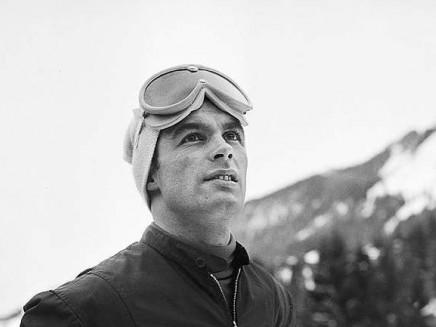
Article Date:
Saturday, January 18, 2014
Who are the greatest racers? Look to the Olympics for the skiers able to
conquer pressure.
By John Fry
With 48 homers and 130 runs batted in, New York Yankees third
baseman Alex Rodriguez was arguably baseball’s best player during the 2005
season, notwithstanding how he did it. But once in the playoffs, over a time
span roughly equal to that of the Olympic Winter Games, Rodriguez was a no-
hit flop.
Mention the greatest skiers of all time, and you usually hear a recitation
of racers with Rodriguez-like stats. . .for example, Sweden’s Ingemar Stenmark
winner of a record 86 World Cup races, and Austria’s Annemarie Proell, with a
women’s record of 62 races won. And there’s Marc Girardelli with more overall
World Cup titles and starts than any racer in history. But you won’t find Proell
or Girardelli on my list of the greatest Olympic racers. Neither one won more
than one gold medal in a single Winter Games. Stenmark didn’t even compete
in the downhill.
No, skiing’s superstars are athletes who don’t appear on lists counting
most races won. They won races that most counted. At clutch time, in the
Olympics, they showed up.
Arguably, the best was 1956 champion Toni Sailer. The margins by
which the Austrian won his gold medals were staggering: 3.5 seconds in
the downhill, a mind-boggling 6.4 seconds in the one-run giant slalom, and
4 seconds in the slalom. At the 1958 World Championships, Sailer almost
repeated his Olympic hat trick, placing first in both downhill and giant slalom,
and second in the slalom. With jet black hair and a movie star’s face, the
handsome, six-foot poster-boy Sailer went on to act in films and, later, in
television mini-series.
Sailer and Jean-Claude Killy are the only racers to have captured all of
the alpine gold medals available to be won in a single Olympics. . .in their eras,
there were just three. (Super G and special combined races hadn’t yet been
introduced.)
Killy, 24, was already an internationally acclaimed champion before
his 1968 Olympic triumph in the French Alps above Grenoble. The previous
winter, in capturing the first overall World Cup title, the Frenchman had
won 71 percent of the races on the calendar, a feat never since repeated. The
pressure on Killy before the Grenoble Games was unimaginably intense. All
day long he was pursued by photographers, autograph seekers and worshipful
fans. To escape, Killy went into seclusion a week before the lighting of the
Olympic flame. When he showed up in the starting gate, he was psyched
and ready. He pulled off the gold medal hat trick, albeit winning by narrower
margins than Sailer enjoyed.
“The greatest racers, in my opinion, win gold at the Olympics and World
Championships,” insists 1970 World Champion Billy Kidd. “The events are
followed on television and in newspapers around the world, and they demand
something that doesn’t come into play in career-long performances and season-
long accumulations of points. . .the ability to win when the chips are down.”
Killy’s and Sailer’s winning all the Olympic alpine races during less than 12 days
and in less than five minutes of competition, are convincing proof to Kidd of
their greatness.
As in tennis and golf, women don’t ski-race with the same strength and
speed as men, but their competitive fervor is no less. In 1952 at Oslo, fiercely
determined Andrea Mead Lawrence won two Olympic gold medals at the age
of only 19, an achievement never equaled by a man. She’s the only American to
win twice in a single Olympics. . . alas, she fell in the downhill.
Germany’s Rosi Mittermaier in 1976 and Liechenstein’s Hanni Wenzel
in 1980 both narrowly missed performing the Sailer-Killy hat trick. After gold-
medaling in the downhill and slalom, Mittermaier came within one-eighth of a
second of winning the giant slalom.
Arguably, the greatest woman ski racer of all time is living among us
today. She is Croatia’s Janica Kostelic, who won three gold medals and a silver
at the Salt Lake Winter Games in 2002.
Then there is 18-season veteran Kjetil Andre Aamodt, whose eight
Olympic medals are a record in alpine skiing.
The greatest perform under pressure, occasionally self-imposed. After
Muhammad Ali talked big and Babe Ruth pointed his finger at the home
run fence, they both delivered. Hermann “the Hermanator” Maier met the
challenge at the 1998 Olympics. After a spectacular airborne, body-crunching
crash in the downhill, he rose like a man from the dead and went on to win
both the Super G and the giant slalom gold medals. Following a nearly fatal
motorcycle crash that left him with a mangled leg, Maier raced again.
The great Olympic champions weren’t guys with prepared excuses
built around the inevitability of averages. They went out and conquered
off-days and the law of averages by winning multiple medals. I bow in
reverence to the golden men and women of our sport.
John Fry covered the ski races at four Winter Olympic Winter Games, and has written for
40 years about the World Cup and the World Alpine Ski Championships.
